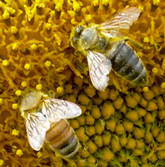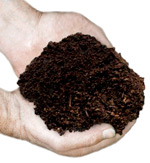Sustainable Gardening
Pest and Disease Control ![]()
Healthy soil and diverse plantings of healthy plants resist damage from unwanted insects. These pests are not as effective and may even be confused, as well as controlled by the beneficials drawn by the diverse plantings in the yard.
* Meet the Beneficials Poster - pdf
Mulching the soil with wood chips/shreds, partially composted leaves and other woody materials helps protect the soil, maintain balanced soil temperatures, increase water infiltration and retention, and helps improve soil texture and prevent soil compaction, control erosion, reduce weeds, as well as providing a slow release source of organic matter (food) for the microorganisms (microherd) in the "Soil Food Web."
Healthy soils breed healthy plants and gardens that are not as susceptible to various attacks from insects and disease.
In spring especially, slugs and snails are attracted to new growth. Containers full of beer divert slugs and snails, so they crawl in and drown. You can also go out to your garden at midnight with a flashlight and kill many of them, or help them into the saucer. After a couple midnight visits, the plant saucer or tuna can full of beer should keep down any problem. They like "Budweiser" beer best and it can be old (even over a month old) and flat or even going moldy; they still are attracted. If your slugs and snails don't like the beer, try spraying the foliage with caffeinated coffee; it works in Hilo HI.
Spreading coffee grounds around your plants may help as well.
Early in spring, aphid queens (they can fly) lay eggs on some tender new growth on plants (mostly on the bottom side of leaves). The young aphids can be washed off the new rose buds, or other new plant growth with water (with a hose) and are unable to crawl back up the plant.
You may get some other nibbling guest here and there but don’t run for the bug spray. If your plants are growing organically and are healthy, the damage is generally cosmetic and rarely is a major threat. It’s better to have food or flowers with a few holes than covered with poisons. All this adds up to a healthier planet and a healthier environment for your family. Another consideration is food security. People are becoming more aware of the importance of local food and wanting to know about where their food comes from.
If you get mildew on a plant, it could be that there is too much overhead watering from sprinklers or from mother nature. Spray with a solution of 1-to-3 milk to water. This is the recommended level in the Netherlands where milk is a Department of Agriculture approved fungicide. This also works for black spot and rust on roses. Many people use kelp spray (Maxicrop) which strengthens the plants. It is best to pick off leaves that are heavily covered with black spot or rust and remove any of these dropped leaves from the bed, unless you add mulch over the leaves.
It is important to know that over time, compost, worm castings and a high quality mulch will heal a depleted soil or a sickly soil biology.
Every year that you garden organically
and add fresh organic matter yearly, your garden becomes more healthy and pests and diseases become less of a problem. Eventually, with simple management practices, there are no real problems; just an ever-changing ecosystem.
* See Keeping Soil Healthy

 For difficult weeds, like nutgrass, crabgrass, or sometimes bermuda grass, the process is a little more difficult & takes longer.
For difficult weeds, like nutgrass, crabgrass, or sometimes bermuda grass, the process is a little more difficult & takes longer.